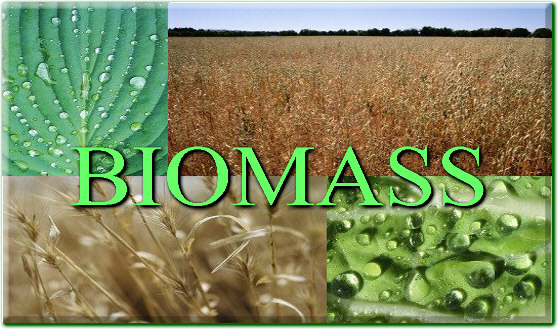|
BIOMASS GASIFICATION
Biomass includes a wide
range of materials, including energy crops such as
switch grass and agricultural all sources such as corn
husks, wood pellets, lumbering and timbering wastes,
yard wastes, construction and demolition waste, and
bio-solids such as sewage sludge. Gasification helps
recover the energy locked in these materials and can
convert biomass to electricity and products, such as
ethanol, methanol, fuels, and fertilizers.
Biomass gasification
plants differ somewhat from the large-scale gasification
processes typically used in major industrial facilities
such as power plants, refineries, and chemical plants,
although the differing types of gasification can easily
be combined.
Feedstock
Biomass usually contains a high percen tage of moisture
which can be 25% (By Weight) in some cases. The presence of high levels of moisture in the biomass
reduces the temperature inside the gasifier, which then
reduces the efficiency of the gasifier. Therefore, many
biomass gasification technologies require that the
biomass be dried to reduce the moisture content prior to
feeding into the gasifier. This can be an added benefit
as the moisture can be taken out and processed into
large quantities of deionized (Distilled) water. Pure
water. tage of moisture
which can be 25% (By Weight) in some cases. The presence of high levels of moisture in the biomass
reduces the temperature inside the gasifier, which then
reduces the efficiency of the gasifier. Therefore, many
biomass gasification technologies require that the
biomass be dried to reduce the moisture content prior to
feeding into the gasifier. This can be an added benefit
as the moisture can be taken out and processed into
large quantities of deionized (Distilled) water. Pure
water.
Air-blown
Gasification
Most biomass gasification systems use air instead of
oxygen for the gasification reactions. Gasifiers that
use oxygen require an air separation unit to provide the
gaseous/liquid oxygen; this is usually not
cost-effective at the smaller scales used in biomass
gasification plants. Air-blown gasifiers use the oxygen
in the air for the gasification reactions.
Scale
of plants
In general, biomass gasification plants are much smaller
than the typical coal or
 petroleum coke gasification
plants used in the power, chemical, fertilizer and
refining industries. As such, they are less expensive
to build and have a smaller facility “footprint”.
While a large industrial gasification plant may take up
150 acres of land and process 2,500-15,000 tons per day
of feedstock (such as coal or petroleum coke), the
smaller biomass plants typically process 25-200 tons of
feedstock per day and take up less than 10 acres. petroleum coke gasification
plants used in the power, chemical, fertilizer and
refining industries. As such, they are less expensive
to build and have a smaller facility “footprint”.
While a large industrial gasification plant may take up
150 acres of land and process 2,500-15,000 tons per day
of feedstock (such as coal or petroleum coke), the
smaller biomass plants typically process 25-200 tons of
feedstock per day and take up less than 10 acres.
Biomass
to Ethanol and Liquid Fuels
Cu rrently, most ethanol
is produced from the fermentation of corn. Vast amounts
of corn and land, water and fertilizer are needed to
produce the ethanol. As more corn is being used, there
is an increasing concern about less corn being available
for food. Gasifying biomass, such as corn stalks, husks,
and cobs, and other agricultural waste products to
produce ethanol and synthetic fuels such as diesel and
jet fuel can help break this energy-food competition. rrently, most ethanol
is produced from the fermentation of corn. Vast amounts
of corn and land, water and fertilizer are needed to
produce the ethanol. As more corn is being used, there
is an increasing concern about less corn being available
for food. Gasifying biomass, such as corn stalks, husks,
and cobs, and other agricultural waste products to
produce ethanol and synthetic fuels such as diesel and
jet fuel can help break this energy-food competition.
Biomass, such as wood
pellets, yard and crop wastes, and “energy crops” such
as switch grass and waste from pulp and paper mills can
be used to produce ethanol and synthetic diesel. The
biomass is first gasified to produce the synthetic gas
(syngas), and then converted via catalytic processes to
these downstream products.

Biomass to Power
Biomass can be used to produce electricity—either
blended with traditional feedstocks, such as coal or by
itself. Nuon’s IGCC plant in Buggenum, Netherlands
blends about 30% biomass with coal in their
gasification process to produce power.
Cutting
Costs, Increasing Energy
Each year, municipalities spend millions of dollars
collecting and disposing of wastes, such as yard wastes
(grass clippings and leaves) and construction and
demolition debris. While some municipalities compost
yard wastes, this takes a separate collection by a city
which is an expense many cities just can’t afford.
Yard waste and
the construction and demolition debris can take up
valuable landfill space, shortening the life of a
landfill. Many cities face a shortage of landfill
space. With gasification, this material is no longer a
waste, but a feedstock for a biomass gasifier. Instead
of paying to dispose of and manage a waste for years in
a landfill, using it as a feedstock reduces disposal
costs, landfill space and converts the waste to power
and fuels.
Benefits
of Biomass Gasification
-
Converting waste
product into high value energy & products
-
Reduced need for
landfill space for disposal of solid wastes
-
Decreased methane
emissions from landfills
-
Reduced risk of
groundwater contamination from landfills
-
Production of ethanol from non-food sources
Information with thanks to the
"Gasification Technologies Council"
NK PAGE
|



